Jewish Corn Bread
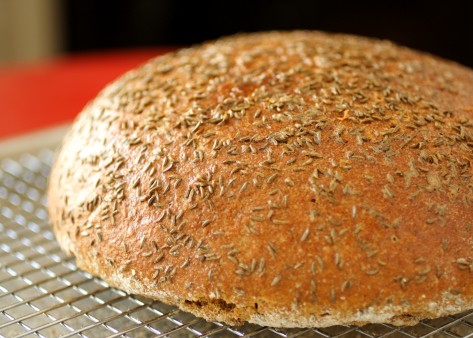
Has a memory of a food ever made you crazy with longing for it? If yes, then you’re a living, breathing human. But what if a memory of a food, so real you can feel, taste, smell, and see it, cannot be substantiated on this planet Earth, making you feel like you might be crazy. Did you imagine that childhood food that no one other than your brothers and sisters, and I mean no one, has heard of? Did you dream it?
It took the current DCCC pick, Secrets of a Jewish Baker, to make Bhakti Ziek, a DCCC club member, realize that in fact her adolescent memory of an unusual rye bread known to her family as “corn bread” was real, and not imagined.
Each week Bhakti’s mother Nona would bring home a large white box tied up with ribbon from a local Jewish bakery on Long Island. Inside the box would be various baked goods and breads—black and white cookies, Danishes, challah bread, rye bread, and the aforementioned corn bread, which Bhakti remembered being dense and chewy and moister than regular rye bread, and with lots more caraway seeds.
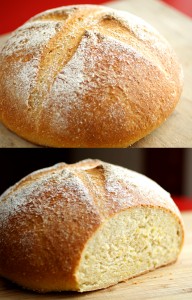
Rustic Sourdough Corn Bread
In Secrets of a Jewish Baker, author and baker George Greenstein includes a recipe for Jewish Corn Bread, named as such no doubt to distinguish it from the several other corn bread recipes in his book: there is Cornmeal Bread, which is a chemically leavened cornbread similar to what Americans typically think of when they think of cornbread; Portuguese Corn Bread, a hearty yeasted bread made with bread flour and fine cornmeal (it’s great for sopping up pork-and-bean soups); and Sourdough Country Corn Bread, a delicious yeasted bread made with a sourdough starter, all-purpose flour, and fine cornmeal (it makes fantastic toast). Unlike the other cornbreads in the book, the mysterious Jewish Corn Bread contains no cornmeal at all. (Note: In the first edition of Secrets of a Jewish Baker [1993], Jewish Corn Bread is simply called “Corn Bread.”)
Bhakti suspected that Greenstein’s Jewish Corn Bread was the same bread she recalled from her youth. After making the recipe, she confirmed that it was indeed the same cherished bread. She is not the only one to hold the bread in such high standing. Greenstein himself writes, “Jewish Corn Bread is the best bread that I know how to make!” (Exclamation his.) The word corn, Greenstein explains, is used in Europe (and this bread is middle European in origin) to mean “grain” or “staples,” which encompasses wheat, oats, rye, barley, and maize (what Europeans call corn).
If you go looking for a loaf of corn bread at a Jewish bakery, it may also be called corn cissel or corn sissel or even corn shissel, the latter three being variations of the Yiddish spelling for caraway. My photograph of the Greenstein’s Jewish Corn Bread is a little misleading; had I not ran out of caraway seeds, the top of the bread would be sprinkled with at least twice as many sissel.
At Karen and Richard Blacker’s kosher bakery in Newton, Massachusetts, called Blacker’s Bakeshop, you will find a corn cissel bread among their offerings. I put in a call to the shop to confirm if their corn cissel bread is the same animal as George Greenstein’s Jewish corn bread. Yes, indeed it is, Karen Blacker affirmed; she said she loves Secrets of a Jewish Baker, and so knew exactly the bread I was referring to. The Blacker’s version, however, does have some corn in it, or on it: The Blackers dust the top of their corn cissel loaves with cornmeal to produce a crustier top.
Outside of a few shops like the Blacker’s, corn bread, or corn sissel, seems to be a bread that is rarely made at Jewish bakeries these days (Nona’s weekly runs to the Jewish bakery to buy corn bread were made during the late fifties and sixties). If you want to try it, you will most likely need to pick up a copy of Greenstein’s book and make it yourself. Having done that myself I can say that the time needed to make a rye starter and the cost and trouble of procuring first clear flour (visit King Arthur Flour) is entirely worth it.
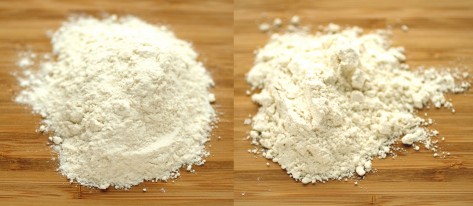
Bread flour (left); First clear flour (right)
According to Greenstein, the use of first clear flour is one of the secrets to making true Jewish rye breads. It is the least refined of the bread flours, and so is a little darker in color than typical bread flour, which helps to create the darker color desired in rye breads. (You can make out its warmer, ivory color as compared to unbleached white bread flour in my photo.) It also has less gluten than most bread flours, according to Greenstein, which allows for the dense, chewy texture associated with rye breads.
Greenstein’s Jewish Corn Bread has personality. It’s a throw-back to bread with big, bold flavors and texture, and to a time when the only preservative used in bread making was the sourdough starters. (It’s the naturally acidic quality of sourdough that helps breads keep for a week at a time without molding.) While authentic Jewish rye bread is a very good thing, Greenstein’s included, Jewish corn bread is an even better thing. It makes the rye and caraway flavor of regular rye bread pale by comparison. While you could argue that the lighter flavor and texture of regular rye bread makes it a more adaptable and multi-purpose bread, I’ll take this crazy no-corn corn bread alone and with just about anything, and on any day.

Jewish Corn Bread with a smear of butter
UPDATE – January 27, 2013:
The corn cissel from Blacker’s Bakeshop is NOT the same bread as George Greenstein’s Jewish Corn Bread, as I say in the posting above. My lesson? Always taste the goods before giving a verdict!
I got a chance to do that last week when, by luck and happenstance, my friend (and club member) Bhakti Ziek got her hands on not only the Corn Cissel from Blacker’s Bakeshop in Newton, Massachusetts, but also the Sissel Bread from The Original Kaplan’s Rainbow Bakery in Cranston, Rhode Island, whose motto is “the best Rye in RI.” Both of these breads are of the same basic type: a light rye with copious amounts of caraways seeds, or cissel/sissel in Yiddish. In fact, they are lighter than the standard rye bread, whereas Greenstein’s Jewish Corn Bread is heavier than the standard rye. And they are large—very large. So it’s a good thing they are light. If they were the same type of bread as Greenstein’s Jewish Corn Bread you wouldn’t be able to lift them.
I am hopeful that the corn ryes described in Andrew Coe’s bakery round-up in “Good Bread: Seeking Out the Best Corn Rye in NYC” are the same type as Greenstein’s Jewish Corn Bread. He describes them as “big lumpy boules with a few puncture marks in their leathery glazed crust.” Add a lot of caraway seeds, and you’ve got a pretty good description of Greenstein’s bread. It’s nice to think that some bakeries somewhere still make this bread. Thank goodness Greenstein put the recipe down in writing; by doing so, he’s made sure it will never be completely lost.
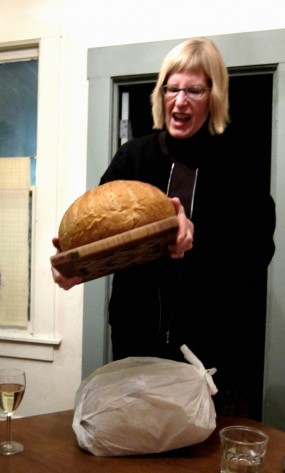
My first encounter with the mamouth dimensions of sissel bread from Kaplan’s Rainbow Bakery. Which can be best described as “What the f&%#?!” As Bhakti said, this photo of me says it all.

The Sissel Bread from Kaplan’s Rainbow Bakery, photographed on a 14 by 20-inch cutting board and with a dinner fork for scale. Despite it’s size, it weighs only just over 3 pounds.
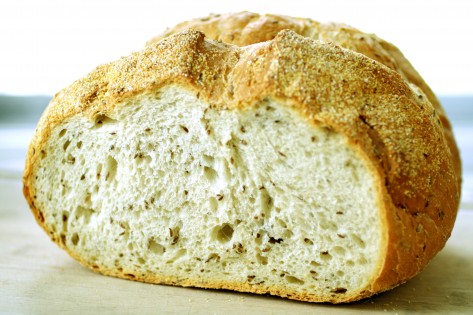
The Corn Cissel from Blacker’s Bakeshop. You can see the dusting of corn on top. Greenstein’s Jewish Corn Bread, on the other hand, is made without any cornmeal at all.

Lovely post Holly. Baking from this book has definitely enriched my Vermont life, bringing back good memories and tastes that I can’t get here. Everything I have made from the book has been delicious. Just want to clarify (since I am into details) that my mom would come home with paper bags of goodies–both arms loaded–and she would set them down on the kitchen counter and we kids would unpack. From the bags would emerge these delicious breads, and the white bakery boxes tied with twisted cotton yarn (is that why I like using variegated yarns in my weavings?) and in those boxes would be the black and whites, the rugalach, and the seven layer cakes. Here is a link to another bakery (I haven’t tried it) whose list of offerings matches my childhood memories: http://www.rainbowbakeryri.com/Menus.html
1Thanks Bhakti. The details are important! And now we know of two bakeries that make this same bread. Thanks for that tip, as well. Perhaps others will add their corn cissel findings and we’ll end up with a nationwide list of bakeries making this fantastic bread. Then, no matter where you are, you could round up a loaf.
2P.S. To add to the research on this bread, I just found this story online about corn bread: http://bit.ly/XGgevV. Apparently a few bakeries in the NYC area still make it.
Holly,
Wonderful, educational post with beautiful pictures. Like Bhakti, I grew up with the exact same breads, 7 layer cake, black and whites, etc. Do you remember Blackout cake Bhakti? A double or triple layer cake with a pudding like filling between layers and a fourth layer of cake, crumbled to cover the entire cake–black out!
But it is the sour dense dark breads that I l remember most. I have loved baking from Greenstein’s book. I am on going into my third month of making breads from the original sour starter. It is most forgiving and nothing gives me greater satisfaction than seeing those fissures form on sour in Stage 1 and 2. The book has been a revelation. Thank you Holly for introducing it to us!
3I will try the corn bread next.
Deb,
That blackout cake sounds amazing. By the way, there’s a recipe for it and a little history about it in an America’s Test Kitchen book called America’s Best Lost Recipes. Now I’m prompted to try, after reading your description.
It’s fantastic that this book has been a trip down memory lane for both you and Bhakti. You both share the Long Island experience, and Greenstein’s bakery was on Long Island. (As far as Bhakti and I could figure out, from doing some online research, his bakery was in Commack.)
I’ve got to say it’s been a pleasure to explore the rye sour breads, too, especially since they aren’t something I’m likely to find easily in rural Vermont. And like you said, Deb, it’s fun to have a “pet” starter in the fridge–something you feed and develop and use again and again. Let us know how your experience with the corn bread goes.
4I DO remember the blackout cake. Entemann’s Bakery used to be a real bakery in Brooklyn and occassionally my mother or a family friend would go there and always buy a blackout cake. Once they started mass-marketing their goods, we could even find them boxed–but they didn’t taste as good as the early ones from the bakery. I haven’t seen them for sale in years and their website doesn’t list it as a product anymore. Wonder why. I will have to check out that recipe and make it myself.
5By the way Deborah, I just bought The Korean Table that you wrote with Taekyung Chung and look forward to using it to make some of my favorite food. Hope we meet sometime. How about lunch in Boston at a Korean restaurant you two?
Just dug a bit more on internet and see that most of what I wrote above is right except the Brooklyn bakery was not Entenmann’s but EBINGER’S. This site has the history of blackout cakes: http://kitchenproject.com/history/ChocolateBlackoutCake/index.htm and also a link to a recipe. That bakery closed in 1972.
6funny from corn bread to blackout cake. ah memory.
In Pittsburgh Allegro bakery in Squirrel makes a really good Russian corn rye. And wonderful rugalach. However the corn rye is not as hearty and wonderful as the real old fashioned kind I remember.
7Charles-
8Thanks for sharing your corn rye tip. Did you grow up eating hearty corn rye in Pittsburgh? According to my friend Bhakti, who grew up eating it, Greenstein’s recipe is the real deal. I hope you try it. It’s a process, but worth it. I promise!
Can you provide the recipe for Greenstein’s Jewish Corn Bread?
9Thank you!
Hi Jessica,
10I can’t provide the recipe because I don’t have permission from the publisher. But it’s worth tracking down a copy of the book through your local library (interlibrary loan is necessary). Or buying it. I hope you try it!
-Holly
I have tried to make Greensteins Corn Bread on several occasions and failed to get the bread to rise fully. I called King Arthur Flour and talked to their team to find out what I was doing wrong, all to no avail. Can you share some suggestions. I followed the recipe with great care, yet ended up with a relatively flat final product. It did taste pretty good, but was far from the real deal of my childhood. Thanks
11Hello Steve! Oh dear, it has been years and years since I made that bread. Well, since 2013 to be exact. I recall loving the flavor, and thinking one day I’d like to return to it (because it’s that good). I think having a super healthy starter is probably one of the keys to getting it right. I’m sorry I’m being so vague. If and when I return to it, and it’s fresh on my mind, I’ll wrangle up some more specific tips for you. P.S. Thanks for reading my posting.
12